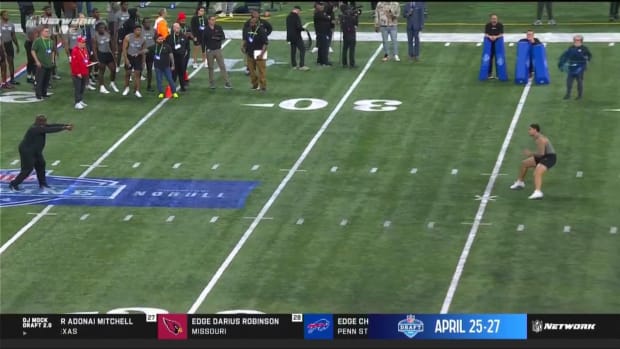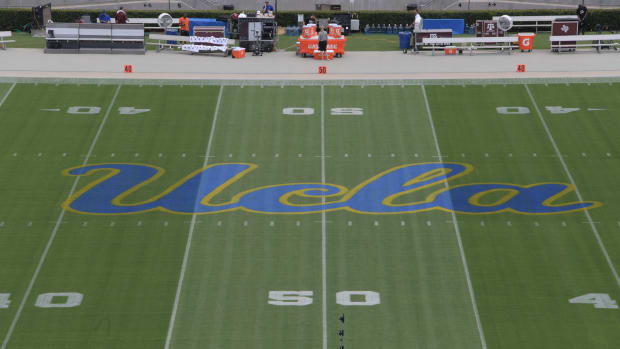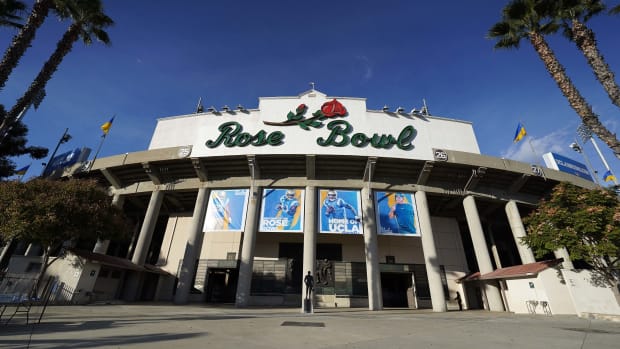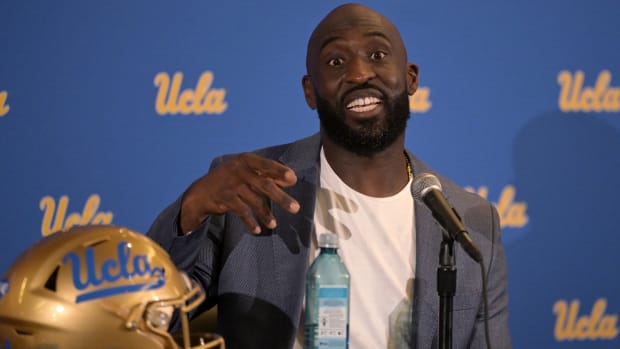UCLA vs. Arizona Week 6: Scouting Report
The Wildcats' win-loss record may show how ineffective they've been so far this year, but it doesn't tell the whole story.
UCLA football (3-2, 1-1 Pac-12) will play Arizona (0-4, 0-1) on Saturday night, having lost to the Wildcats the last time they went to Tucson, but winning seven of the previous nine matchups overall. This is a new Arizona team undergoing a lot of turnover, however, as former UCLA offensive coordinator Jedd Fisch has stepped in to replace Kevin Sumlin, who was only there for three seasons taking the place of Rich Rodriguez.
Brennan Carroll, the son of Seattle Seahawks coach Pete Carroll, is the Wildcats' offensive coordinator, but it's Fisch who's really in charge on that side of the ball. Defensive coordinator Don Brown comes over from Michigan and also had previous stops at Boston College, Maryland and UMass. This is the first year the staff has been together.
So with Fisch's past and the first four games of 2021 in mind, here's a quick rundown of what Arizona might look like come Saturday.
Arizona Offense vs. UCLA Defense
Arizona Passing Yards/Game: 253.5 yards
Arizona Rushing Yards/Game: 110.0 yards
UCLA Passing Yards Allowed/Game: 321.4 yards
UCLA Rushing Yards Allowed/Game: 87.4 yards
Fisch simply doesn't have that much to work with this year.
At quarterback, he's had to rotate through the first third of the year, with each of his three options boasting very different body types and skillsets. 6-foot-5 Gunner Cruz was up first, followed by 6-foot-1 true freshman Will Plummer and then 6-foot South Florida transfer Jordan McCloud.
The revolving door seems to have stopped, with McCloud coming in in relief in Week 3 and starting Week 4. The most experienced and dynamic of the bunch, McCloud stands out as the best signal-caller of the trio, but that doesn't mean he's without his limitations.
Arm strength and making contested throws are not two of McCloud's strong suits, for starters. When he tried to mount a comeback against Northern Arizona, he showed confidence down the stretch and made this nice back corner throw to keep his team in it.
That confidence and even the play-calling was likely a product of playing an FCS opponent with inferior talent on the outside, however. McCloud was 6-of-7 with 66 yards and a touchdown in his very limited time on the field that game, and he was honestly picking them apart at every turn.
The following week against Oregon, McCloud's cracks started to show.
Instead of trusting his quarterback to throw contested corner fades, Fisch started dialing up screens and bootlegs to work short passes even in the red zone, as seen on McCloud's lone touchdown of that game.
McCloud threw five interceptions against the Ducks, one on a backpedalling failed slip screen, another on an end zone jump ball, one more on a late and telegraphed corner route and another when looked off the screen and tried throwing deep into zone double coverage.
His vision, decision making and raw arm talent just are not where they need to be, although he can make up for it at times with his legs.
Fisch called a few designed runs for McCloud against Oregon, and McCould has the speed to get to the outside and turn the corner successfully. Arizona like to pull tackles and bring misdirections to catch defenses flat footed, and this is something they're really only able to do with McCloud at the helm.
With that style of quarterback, it would seem the Wildcats would have to rely on the running game to move the ball, but that isn't really the case.
Running backs Drake Anderson and Michael Wiley, the only two backs who really get snaps for Arizona, are combining for just 78.5 rushing yards per game on 3.7 yards per carry. The offensive line is experienced and physical enough to justify running the ball – from left to right, they have Jordan Morgan, Donovan Laie, Josh McCauley, Josh Donovan and Paiton Fears, and only the sophomore Morgan isn't an upperclassman – but their inside run game has just failed miserably this season.
Before McCloud took over as the starter, Arizona was averaging 79.3 rushing yards per game without a single touchdown on the ground. The Wildcats rushed for 202 yards and a touchdown when McCloud drew the start against the Ducks, but that was still on just 3.8 yards per carry.
The rushing attack, even after seeing improvement with McCloud joining the fray, is not something UCLA should be all too worried about. While yes, part of the reason the Bruins are allowing just 87.4 rushing yards per game is because teams are so pass-happy against them, they still boast the talent and scheme that should shut down Anderson and Wiley at the very least, if not McCloud's dual-threat ability as well.
UCLA's now infamous pass defense will probably invite Arizona to throw the ball around a bit, but McCloud doesn't have very many top options through the air. Receiver Stanley Berryhill III has more than double the number of receptions and yards as the next most productive Wildcat wideout with 8.3 catches for 84.5 yards per game.
6-foot-2 Boobie Curry is their most reliable red zone threat with two touchdowns on the year, and he joins Tayvian Cunningham and Brian Casteel as the other Arizona receivers who are averaging between 25 and 50 yards per game.
On a talent level, the Bruins should be able to shut down the Wildcats no matter what they try to do. Arizona currently ranks No. 122 and No. 124 out of 130 teams in yards per drive and yards per play, respectively.
But looking at how easily the Sun Devils seemed to carve them up on both screens and verticals last week, even Arizona could be capable of racking up yards and points on UCLA.
Arizona Defense vs. UCLA Offense
UCLA Passing Yards/Game: 234.4 yards
UCLA Rushing Yards/Game: 203.6 yards
Arizona Passing Yards Allowed/Game: 172.0 yards
Arizona Rushing Yards Allowed/Game: 191.8 yards
Brown has earned the nickname "Dr. Blitz" for a reason – he brings a lot of pressure.
In the passing game, that pressure has yet to get home on a consistent basis.
Arizona has just six sacks through four games, and almost half of them are from defensive lineman Kyon Barnes. UCLA probably hasn't faced an interior lineman as disruptive as Barnes so far this season, but with the rest of the line's complete lack of a presence in the pass rush, it should be simple to neutralize him.
The Wildcats' 6.0 tackles for loss per game is tied for 60th in the country, so it isn't as if they've lived in the backfield in 2021.
Overall, Arizona's run defense is just awful.
That's despite the fact that the Wildcats bring a good amount of size on their defensive line between Barnes, JB Brown, Trevon Mason and Jalen Harris. Their production is poor, allowing nearly 200 yards per game on the ground, but watching the film makes it look so much worse.
Take a look at this play from the final minutes against Northern Arizona – an FCS program, mind you – from back in September:
Just looking at the situation, the defense should be selling out for the run, with the Wildcats out of timeouts and the Lumberjacks obviously looking to run clock with a two-point lead in hand. But three defensive backs go nowhere near the line of scrimmage of this play, and one of them who does – cornerback Isaiah Rutherford, No. 2 – takes the complete wrong angle on the outside and virtually removes himself from the play.
In addition to letting the FCS offensive line bully and fool them into allowing the ball-carrier to make it 3 yards pass the line of scrimmage before creating contact, the FCS running back breaks two tackles at once, then carries three or four defenders several more yards for the first down when the one thing Arizona couldn't do was allow a first down.
If that's all the Wildcats can muster up against inferior talent in a clear run-first scenario, just imagine what Zach Charbonnet and Brittain Brown will be able to do to them with even the slightest amount of misdirection and passing threat out of quarterback Dorian Thompson-Robinson.
The second level is probably where Arizona has the most talent, with linebacker Anthony Pandy and his seven tackles per game standing out above the rest. Treshaun Howard, Jerry Roberts, and Kenny Herbert also bring a lot of experience to the linebacking corps, as they are all fourth-year players.
Thompson-Robinson, when he does drop back to pass, will be going against a secondary that is wildly inexperienced and is not particularly good at finishing tackles themselves. Christian Roland-Wallace and Isaiah Rutherford are both sophomores, and so is safety Jaxen Turner, while free safety Jaydin Young is a freshman. All four of those guys are 6-feet or taller, so what they lack in experience, they at least make up for in length.
Arizona has forced just three turnovers in four games, meaning they likely won't be the team that causes UCLA to start giving the ball away multiple times in a game.
Schematically, expect the Wildcats to go all out for stopping the run, and then expect the Bruins to successfully run the ball anyways. UCLA will string together some long, methodical drives, beating Arizona up front and letting the ground game carry them to scoring drive after scoring drive.
Follow Connon on Twitter at @SamConnon
Follow All Bruins on Twitter at @SI_AllBruins
Like All Bruins on Facebook at @SI.AllBruins
Subscribe to All Bruins on YouTube
Read more UCLA stories: UCLA Bruins on Sports Illustrated
Read more UCLA football stories: UCLA Football on Sports Illustrated




